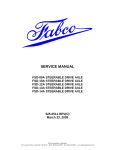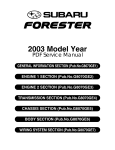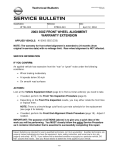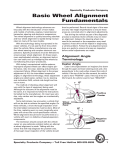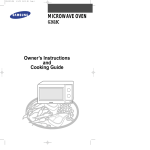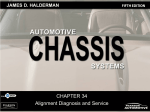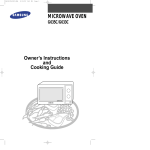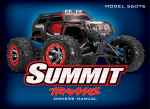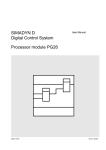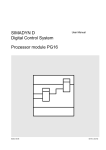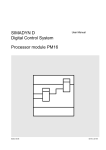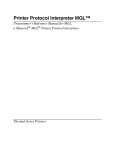Download 2003 FORESTER SERVICE MANUAL QUICK REFERENCE INDEX
Transcript
2003 FORESTER SERVICE MANUAL QUICK REFERENCE INDEX CHASSIS SECTION This service manual has been prepared to provide SUBARU service personnel with the necessary information and data for the correct maintenance and repair of SUBARU vehicles. This manual includes the procedures for maintenance, disassembling, reassembling, inspection and adjustment of components and diagnostics for guidance of experienced mechanics. Please peruse and utilize this manual fully to ensure complete repair work for satisfying our customers by keeping their vehicle in optimum condition. When replacement of parts during repair work is needed, be sure to use SUBARU genuine parts. FRONT SUSPENSION FS REAR SUSPENSION RS WHEEL AND TIRE SYSTEM WT DIFFERENTIALS DI TRANSFER CASE TC DRIVE SHAFT SYSTEM DS ABS ABS ABS (DIAGNOSTICS) ABS BRAKE BR PARKING BRAKE PB POWER ASSISTED SYSTEM (POWER STEERING) PS All information, illustration and specifications contained in this manual are based on the latest product information available at the time of publication approval. FUJI HEAVY INDUSTRIES LTD. G8070GE5 FRONT SUSPENSION FS 1. 2. 3. 4. 5. 6. 7. 8. 9. Page General Description ....................................................................................2 Wheel Alignment .........................................................................................7 Front Transverse Link ...............................................................................16 Front Ball Joint ..........................................................................................18 Front Strut .................................................................................................19 Front Stabilizer ..........................................................................................23 Front Crossmember ..................................................................................24 Sub Frame ................................................................................................25 General Diagnostic Table..........................................................................26 GENERAL DESCRIPTION FRONT SUSPENSION 1. General Description A: SPECIFICATIONS Front Item Camber (Tolerance: ±0°45′) Caster (Reference) Toe-in Kingpin angle (Reference) Non-turbo Wheel arch height (Tolerance: +12/−24 mm (+0.47/−0.94 in) Diameter of stabilizer Camber (Tolerance: ±0°45′) Toe-in Thrust angle Rear Wheel arch height (Tolerance: +12/−24 mm (+0.47/−0.94 in) Diameter of stabilizer Turbo −0°25′ 3°03′ 0±3 mm (0±0.12 in) Each toe angle: 0°±0°07′30″ 13°12′ 437 mm (17.20 in) 21 mm (0.83 in) −0°50′ −0°55′ 2±3 mm (0.079±0.118 in) Each toe angle: 0°05′±0°07′30″ 0°±30′ 440 mm 435 mm (17.32 in) (17.13 in) 17 mm (0.67 in) NOTE: • Front and rear toe-ins and front camber can be adjusted. If toe-in or camber tolerance exceeds specifications, adjust toe-in and camber to the middle value of specification. • The other items indicated in the specification table cannot be adjusted. If the other items exceeds specifications, check suspension parts and connections for deformities; replace with new ones as required. FS-00001 (1) Front A − B = Positive: Toe-in, Negative: Toe-out α = Each toe angle FS-2 GENERAL DESCRIPTION FRONT SUSPENSION B: COMPONENT (1) T5 (2) T1 (3) (17) (28) T12 (4) T6 T10 (28) (28) (18) (5) T9 (19) (20) (7) (8) T7 (21) (6) (28) (16) T13 (15) (22) (9) (11) (27) T4 T4 (28) (23) (10) (28) T6 (24) (14) (13) (12) (28) T2 (25) (29) T2 (26) (29) T8 (30) T8 (31) (28) T11 T6 T8 FS-00057 FS-3 GENERAL DESCRIPTION FRONT SUSPENSION (1) (2) (3) (4) (5) (6) (7) (8) (9) (10) (11) (12) (13) (14) (15) (16) Front crossmember Bolt ASSY Housing Washer Stopper rubber (Rear) Rear bushing Stopper rubber (Front) Ball joint Transverse link Cotter pin Front bushing Stabilizer link Clamp Bushing Stabilizer Jack up plate (17) (18) (19) (20) (21) (22) (23) (24) (25) (26) (27) (28) (29) (30) (31) Dust seal Strut mount Spacer Upper spring seat Rubber seat Dust cover Helper Coil spring Damper strut Adjusting bolt Castle nut Self-locking nut Sub frame Cover Clip FS-4 Tightening torque: N·m (kgf-m, ft-lb) T1: 20 (2.0, 14.5) T2: 25 (2.5, 18.1) T3: 40 (4.1, 30) (Further tighten the bolts within 60° ) T4: T5: T6: T7: T8: T9: T10: T11: T12: T13: 45 (4.6, 33) 50 (5.1, 37) 55 (5.6, 41) 70 (7.1, 51.6) 71 (7.2, 52) 100 (10.2, 74) 125 (12.7, 92.3) 175 (17.8, 129) 190 (19.4, 140) 250 (25.5, 184) GENERAL DESCRIPTION FRONT SUSPENSION C: CAUTION • Wear working clothing, including a cap, protective goggles, and protective shoes during operation. • Before removal, installation or disassembly, be sure to clarify the failure. Avoid unnecessary removal, installation, disassembly, and replacement. • Use SUBARU genuine grease etc. or the equivalent. Do not mix grease etc. with that of another grade or from other manufacturers. • Be sure to tighten fasteners including bolts and nuts to the specified torque. • Place shop jacks or safety stands at the specified points. • Before securing a part on a vise, place cushioning material such as wood blocks, aluminum plate, or shop cloth between the part and the vise. FS-5 GENERAL DESCRIPTION FRONT SUSPENSION D: PREPARATION TOOL 1. SPECIAL TOOLS ILLUSTRATION TOOL NUMBER 927380001 DESCRIPTION ADAPTER REMARKS Used as an adapter for camber & caster gauge when measuring camber and caster. (1) 28199AC000 PLATE (2) 28199AC010 BOLT 927680000 INSTALLER & REMOVER SET Used for replacing transverse link bushing. 927760000 STRUT MOUNT SOCKET Used for disassembling and assembling strut and shock mount. ST-927380001 ST-927680000 ST-927760000 2. GENERAL PURPOSE TOOLS TOOL NAME Alignment gauge Turning radius gauge Toe-in gauge Dial gauge Coil spring compressor REMARKS Used for wheel alignment measurement. Used for wheel alignment measurement. Used for toe-in measurement. Used for damper strut measurement. Used for strut disassembly/assembly. FS-6 WHEEL ALIGNMENT FRONT SUSPENSION 2. Wheel Alignment A: INSPECTION Check the following items before taking wheel alignment measurement. Check items before taking wheel alignment measurement: • tire air pressure • unbalanced right and left tire wear, size difference • tire run-out • ball joint excessive play, wear • tie rod end excessive play, wear • wheel bearing excessive play • right and left wheel base imbalance • steering link part deformed, excessive play • suspension part deformed, excessive play Check, adjust and/or measure the wheel alignment in accordance with procedures indicated in the figure: Wheel arch height (Front and rear) <Ref. to FS-8, WHEEL ARCH HEIGHT, INSPECTION, Wheel Alignment.> ↓ Camber (Front and rear) <Ref. to FS-9, CAMBER, INSPECTION, Wheel Alignment.> ↓ Caster (Front) <Ref. to FS-10, CASTER, INSPECTION, Wheel Alignment.> ↓ Steering angle <Ref. to FS-11, STEERING ANGLE, INSPECTION, Wheel Alignment.> ↓ Front wheel toe-in <Ref. to FS-11, FRONT WHEEL TOE-IN, INSPECTION, Wheel Alignment.> ↓ Rear wheel toe-in <Ref. to FS-12, REAR WHEEL TOE-IN, INSPECTION, Wheel Alignment.> ↓ Thrust angle <Ref. to FS-14, THRUST ANGLE, INSPECTION, Wheel Alignment.> FS-7 WHEEL ALIGNMENT FRONT SUSPENSION 1. WHEEL ARCH HEIGHT 1) Set the vehicle on a level surface. 2) Set the vehicle to “curb weight” conditions. (Empty luggage compartment, install spare tire, jack, service tools, and top up fuel tank.) 3) Set the steering wheel in a straight line, then remove the vehicle straight ahead more than 5 m (16 ft) to settle the suspension. 4) Suspend the thread from wheel arch (point “A” in figure below) to determine a point directly above center of wheel. 5) Measure the distance between measuring point “A” and center of wheel. (2) (3) (1) A (1) A (6) A (7) (4) (1) (5) (8) FS-00012 (1) (2) (3) Wheel arch height Front fender Rear quarter (4) (5) (6) Front wheel arch height Rear wheel arch height Flange bend line (7) (8) Measuring point End of spindle Specified wheel arch height Front Turbo Non-Turbo Rear 435 437 +12/−24 mm (17.20 +0.47/−0.94 in) +12 /−24 mm (17.13 +0.47/−0.94 in) 440 +12/−24 mm (17.32 +0.47/−0.94 in) FS-8 WHEEL ALIGNMENT FRONT SUSPENSION 2. CAMBER • Inspection 1) Place the front wheel on turning radius gauge. Make sure ground contacting surfaces of front and rear wheels are set at the same height. 2) Set the ST into the center of wheel, and then install the wheel alignment gauge. ST 927380001 ADAPTER NOTE: Moving the adjusting bolt by one scale graduation changes camber by approx. 0°10′. (1) (4) (6) (5) (7) FS-00007 (1) Alignment gauge (2) Turning radius gauge (2) 3) Follow the wheel alignment gauge operation manual to measure camber angle. NOTE: Refer to the “SPECIFICATIONS” for camber values. Front: <Ref. to FS-2, SPECIFICATIONS, General Description.> Rear: <Ref. to RS-2, SPECIFICATIONS, General Description.> • Front Camber Adjustment 1) Loosen the two self-locking nuts located at lower front portion of strut. NOTE: When adjusting bolt needs to be loosened or tightened, hold its head with a wrench and turn selflocking nut. 2) Turn the camber adjusting bolt so that camber is set at the specification. FS-9 (3) FS-00008 (1) (2) (3) (4) (5) (6) (7) Strut Adjusting bolt Housing Outer Inner Camber is increased. Camber is decreased. WHEEL ALIGNMENT FRONT SUSPENSION Camber is increased. Rotate camber adjusting bolt LH counterclockwise. Rotate camber adjusting bolt RH clockwise. FS-00009 FS-00010 Camber is decreased Rotate camber adjusting bolt LH clockwise. Rotate camber adjusting bolt RH counterclockwise. FS-00009 FS-00010 2) Set the ST into the center of wheel, and then install the wheel alignment gauge. ST 927380001 ADAPTER 3) Tighten new two self-locking nuts. Tightening torque: 175 N·m (17.8 kgf-m, 129 ft-lb) 3. CASTER • Inspection 1) Place the front wheel on turning radius gauge. Make sure ground contacting surfaces of front and rear wheels are set at the same height. FS-00007 (1) Alignment gauge (2) Turning radius gauge 3) Follow the wheel alignment gauge operation manual to measure caster angle. NOTE: Refer to the “SPECIFICATIONS” for caster values. <Ref. to FS-2, SPECIFICATIONS, General Description.> FS-10 WHEEL ALIGNMENT FRONT SUSPENSION 4. STEERING ANGLE 4) Measure the distance “B” between right and left marks. Toe-in can then be obtained by the following equation: • Inspection 1) Place the vehicle on a turning radius gauge. 2) While depressing the brake pedal, turn the steering wheel fully to the right and left. With the steering wheel held at each fully turned position, measure both the inner and outer wheel steering angle. A − B = Toe-in Steering angle: Inner wheel Outer wheel 36°24′±1°30′ 32°±1°30′ • Adjustment 1) Turn the tie-rod to adjust steering angle of both inner and outer wheels. 2) Check the toe-in. FS-00015 • Adjustment 1) Make sure that the right and left steering angles are within specified value. 2) Loosen the right and left side steering tie-rods lock nuts. 3) Turn the right and left tie rods equal amounts until the toe-in is at the specification. Both the right and left tie-rods are right-hand threaded. To increase toe-in, turn both tie-rods clockwise equal amounts (as viewed from inside of the vehicle). NOTE: Correct the boot if it is twisted. FS-00014 (1) Lock nut 5. FRONT WHEEL TOE-IN • Inspection Toe-in: 0±3 mm (0±0.12 in) 1) Set the toe-in gauge to rear sides of right and left front tires at height correspanding to center of spindle. 2) Mark eath right and left tires at height correspanding to center of spindle and measure the distance “A” between marks. 3) Move the vehicle forward to rotate wheels 180°. NOTE: Whenever rotating the wheels, drive the vehicle forward. FS-00014 (1) Lock nut 4) Tighten the tie-rod lock nut. Tightening torque: 85 N·m (8.7 kgf-m, 62.9 ft-lb) NOTE: Correct the tie-rod boot, if it is twisted. FS-11 WHEEL ALIGNMENT FRONT SUSPENSION 6. REAR WHEEL TOE-IN • Inspection Toe-in: 2±3 mm (0.079±0.118 in) For rear toe-in inspection procedure, refer to FRONT WHEEL TOE-IN procedure. <Ref. to FS11, FRONT WHEEL TOE-IN, INSPECTION, Wheel Alignment.> • Adjustment 1) Loosen the self-locking nut on inner side of link rear. NOTE: When loosening or tightening the adjusting bolt, hold the bolt head and turn self-locking nut. FS-00017 (1) Adjusting bolt (2) Link rear 2) Turn the adjusting bolt head until toe-in is at the specification. NOTE: When right and left wheels are adjusted for toe-in at the same time, the movement of one scale graduation changes toe-in by approx. 1.5 mm (0.6 in). FS-12 WHEEL ALIGNMENT FRONT SUSPENSION Toe-in is increased. Rotate camber adjusting bolt LH clockwise. Rotate camber adjusting bolt RH counterclockwise. FS-00018 FS-00019 Toe-in is decreased. Rotate camber adjusting bolt LH counterclockwise. Rotate camber adjusting bolt RH clockwise. FS-00019 3) Tighten a new self-locking nut. Tightening torque: 100 N·m (10.2 kgf-m, 74 ft-lb) FS-13 FS-00018 WHEEL ALIGNMENT FRONT SUSPENSION 7. THRUST ANGLE • Inspection 1) Position the vehicle on a level surface. 2) Move the vehicle 3 to 4 m (10 to 13 ft) directly forward. 3) Determine the center lines of front axle loci and rear axle loci. 4) Measure the distance “L” between center line of loci of the axles. 3) When the right and left adjusting bolts are turned incrementally by one graduation in the same direction, the thrust angle will change approx. 16′ [“L” is almost equal to 12 mm (0.472 in)]. Thrust angle: 0°±30 ′ Thrust angle: Less than 30 ′ when “L” is less than 22 mm (0.9 in). FS-00022 (1) Center line of loci (front axle) (2) Center line of loci (rear axle) NOTE: Thrust angle refers to a mean value of right and left rear wheel toe angles in relation to the vehicle body center line. Vehicle is driven straight in the thrust angle direction while swinging in the oblique direction depending on the degree of the mean thrust angle. FS-00022 (1) Center line of loci (front axle) (2) Center line of loci (rear axle) • Adjustment 1) Make the thrust angle adjustments by turning toe-in adjusting bolts of rear suspension equally in the same direction. 2) When one rear wheel is adjusted in a toe-in direction, adjust the other rear wheel equally in toeout direction, in order to make thrust angle adjustment. FS-00024 (1) Front (2) Thrust angle (3) Body center line FS-14 WHEEL ALIGNMENT FRONT SUSPENSION Thrust angle: γ = (α − β)/2 α: Right rear wheel toe-in angle β: Left rear wheel toe-in angle Here, use only positive toe-in values from each wheel to substitute for α and β in the equation. FS-00025 (1) Front (2) Body center line FS-15 FRONT TRANSVERSE LINK FRONT SUSPENSION 3. Front Transverse Link B: INSTALLATION A: REMOVAL 1) Temporarily tighten the two bolts used to secure rear bushing of transverse link to body. 1) Set the vehicle on the lift. 2) Lift-up the vehicle and remove the wheel. 3) Remove the sub frame. 4) Disconnect the stabilizer link from transverse link. 5) Remove the bolt securing ball joint of transverse link to housing. NOTE: These bolts should be tightened to such an extent that they can still move back and forth in the oblong shaped hole in the bracket (which holds the bushing). 2) Install the bolts used to connect transverse link to crossmember and temporarily tighten with a new self-locking nut. 3) Insert the ball joint into housing. 4) Connect the stabilizer link to transverse link, and temporarily tighten a new self-locking nut. FS-00026 6) Remove the nut (do not remove bolt) securing transverse link to crossmember. 7) Remove the two bolts securing bushing bracket of transverse link to the vehicle body at rear bushing location. FS-00026 5) Tighten the following points in the order shown below when wheels are in full contact with the ground and vehicle is curb weight. (1) Transverse link and stabilizer Tightening torque: 45 N·m (4.6 kgf-m, 33 ft-lb) (2) Transverse link and crossmember Tightening torque: 125 N·m (12.7 kgf-m, 92.3 ft-lb) (3) Transverse link rear bushing and body FS-00027 8) Extract the ball joint from housing. 9) Remove the bolt securing transverse link to crossmember, and then extract the transverse link from crossmember. Tightening torque: 100 N·m (10.2 kgf-m, 74 ft-lb) 6) Check the wheel alignment and adjust if necessary. FS-00028 FS-16 FRONT TRANSVERSE LINK FRONT SUSPENSION C: DISASSEMBLY D: ASSEMBLY 1. FRONT BUSHING 1. FRONT BUSHING Using the ST, press the front bushing out of place. ST 927680000 INSTALLER & REMOVER SET Assemble in the reverse order of disassembly. CAUTION: Install the front bushing in correct direction, as shown in the figure. (1) (2) (3) FS-00031 FS-00016 2. REAR BUSHING 1) Scribe an aligning mark on the transverse link and rear bushing. 2) Loosen the nut and remove rear bushing. (1) Face bushing toward center of ball joint (2) Ball joint (2) 90°±3° 2. REAR BUSHING 1) Install the rear bushing to transverse link and align aligning marks scribed on the two. 2) Tighten a new self-locking nut. NOTE: While holding the rear bushing so as not to change position of aligning marks, tighten the self-locking nut. FS-00032 Tightening torque: 190 N·m (19.4 kgf-m, 140 ft-lb) E: INSPECTION 1) Check the transverse link for wear, damage and cracks, and correct or replace if defective. 2) Check the bushings for cracks, fatigue or damage. 3) Check the rear bushing for oil leaks. FS-17 FRONT BALL JOINT FRONT SUSPENSION 4. Front Ball Joint C: INSPECTION A: REMOVAL 1) Measure the play of ball joint by the following procedures. Replace with a new one when the play exceeds specified value. (1) With 686 N (70 kgf, 154 lb) loaded in direction shown in the figure, measure the dimension 21. 1) Remove the wheel. 2) Pull out the cotter pin from ball stud, remove the castle nut, and extract the ball stud from transverse link. 3) Remove the bolt securing ball joint to housing. FS-00035 FS-00034 (2) With 686 N (70 kgf, 154 lb) loaded in opposite direction shown in the figure, measure the dimension 22. 4) Extract the ball joint from housing. B: INSTALLATION 1) Install the ball joint onto housing. Tightening torque (Bolt): 50 N·m (5.1 kgf-m, 37 ft-lb) CAUTION: Do not apply grease to tapered portion of ball stud. 2) Connect the ball joint to transverse link. Tightening torque (Castle nut): 40 N·m (4.1 kgf-m, 30 ft-lb) 3) Retighten the castle nut further within 60° until a slot in castle nut is aligned with the hole in ball stud end, then insert a new cotter pin and bend it around castle nut. 4) Install the front wheel. FS-00036 (3) Calculate plays from the following formula. S = 22 − 21 (4) When plays are larger than the following value, replace with a new one. FRONT BALL JOINT Specified play for replacement: S Less than 0.3 mm (0.012 in) 2) When the play is smaller than specified value, visually inspect the dust cover. If the dust cover is damaged, replace with a new ball joint. 3) The ball joint and cover that have been removed must be checked for wear, damage or cracks, and any defective part must be replaced. FS-18 FRONT STRUT FRONT SUSPENSION 5. Front Strut 6) Remove the three nuts securing strut mount to body. A: REMOVAL 1) Remove the wheel. 2) Remove the bolt securing brake hose from strut. FS-00037 3) Scribe an alignment mark on the camber adjusting bolt which secures strut to housing. 4) Remove the bolt securing ABS sensor harness. FS-00039 B: INSTALLATION 1) Install the strut mount at upper side of strut to body, and then tighten with nuts. FS-00038 5) Remove the two bolts securing housing to strut. NOTE: While holding the head of adjusting bolt, loosen self-locking nut. Tightening torque: 20 N·m (2.0 kgf-m, 14.5 ft-lb) 2) Position the aligning mark on camber adjustment bolt with aligning mark on lower side of strut. Install the strut to housing with a new self-locking nut. NOTE: While holding the head of adjusting bolt, tighten self-locking nut. Tightening torque: 175 N·m (17.8 kgf-m, 129 ft-lb) 3) Install the ABS sensor harness to strut. Tightening torque: 33 N·m (3.4 kgf-m, 24.3 ft-lb) 4) Install the bolts which secure brake hose to strut. Tightening torque: 33 N·m (3.4 kgf-m, 24.3 ft-lb) 5) Install the wheels. NOTE: Check the wheel alignment and adjust if necessary. FS-19 FRONT STRUT FRONT SUSPENSION C: DISASSEMBLY (4) Fully contract the piston rod. (5) Repeat three or four times from the first step. 1) Using a coil spring compressor, compress the coil spring. NOTE: After completely purging air from the strut, be sure to place the strut with piston rod facing up. If it is laid down, check for entry of air in the strut as outlined under “Checking for the presence of air”. 4) Using a coil spring compressor, compress the coil spring. NOTE: Make sure that the installing direction of coil spring is as shown in the figure. FS-00040 2) Using the ST, remove the self-locking nut. ST 927760000 STRUT MOUNT SOCKET FS-00042 (1) Flat (top side) (2) Identification paint (3) Inclined (bottom side) FS-00041 3) Remove the strut mount, upper spring seat and rubber seat from strut. 4) Gradually decreasing the compression force of compressor, and then remove the coil spring. 5) Remove the dust cover and helper spring. 5) Set the coil spring correctly so that its end face fits well into the spring seat as shown in the figure. D: ASSEMBLY 1) Before installing the coil spring, strut mount, etc., on the strut, check for the presence of air in the damping force generating mechanism of the strut since air prevents proper damping force from being produced. 2) Checking for the presence of air (1) Place the strut vertically with piston rod facing up. (2) Move the piston rod to center of its entire stroke. (3) While holding the piston rod end with fingertips, move the rod up and down. (4) If the piston rod moves at least 10 mm (0.39 in) in the former step, purge air from the strut. 3) Air purging procedure (1) Place the strut vertically with piston rod facing up. (2) Fully extend the piston rod. (3) With the piston rod fully extended, place the piston rod side down. The strut must stand vertically. FS-00043 (1) Coil spring end face 6) Install the helper and dust cover to the piston rod. 7) Pull the piston rod fully upward, and install the rubber seat and spring seat. FS-20 FRONT STRUT FRONT SUSPENSION NOTE: Ensure that upper spring seat is positioned as shown in the figure. E: INSPECTION Check the disassembled parts for cracks, damage and wear, and replace with new parts if defective. 1. DAMPER STRUT FS-00044 (1) Outside of body 8) Install the strut mount to the piston rod, and then tighten a new self-locking nut temporarily. 9) Using a hexagon wrench to prevent strut rod from turning, tighten the self-locking nut with ST. ST 927760000 STRUT MOUNT SOCKET 1) Check for oil leakage. 2) Move the piston rod up and down to check that it operates smoothly without any binding. 3) Play of piston rod • Measure the play as follows: Fix outer shell and fully extend the rod. Set a dial gauge at the end of rod: L [10 mm (0.39 in)], then apply a force of W [20 N (2 kgf, 4 lb)] to threaded portion. With the force of 20 N (2 kgf, 4 lb) applied, read dial gauge indication: P1. Apply a force of 20 N (2 kgf, 4 lb) in the opposite direction of “W”, then read dial gauge indication: P2. Tightening torque: 55 N·m (5.6 kgf-m, 41 ft-lb) FS-00046 Limit of play (P1 + P2) : 0.8 mm (0.031 in) If the play is greater than limit, replace the strut. 2. STRUT MOUNT FS-00041 10) Loosen the coil spring carefully. Check the rubber part for creep, cracks and deterioration, and replace it with a new one if defective. 3. DUST COVER If any cracks or damage are found, replace it with a new one. 4. COIL SPRING One having permanent strain should be replaced with a new one. When the vehicle posture is uneven, although there are no considerable reasons like tire puncture, uneven loading, etc., check the coil spring for its free length referring to specifications, cracks, etc., and replace it with a new one if defective. 5. HELPER Replace it with a new one if cracked or damaged. FS-21 FRONT STRUT FRONT SUSPENSION F: DISPOSAL CAUTION: • Before handling gas filled struts, be sure to wear goggles to protect eyes from gas, oil and/ or filings. • Do not disassemble the strut damper or place into a fire. • Drill holes before disposing of gas filled struts. 1) Place the gas filled strut on a flat and level surface with piston rod fully extended. 2) Using a 2 to 3 mm (0.08 to 0.12 in) dia. drill, make holes in areas shown in the figure. (1) FS-00047 (1) 40 mm (1.57 in) FS-22 FRONT STABILIZER FRONT SUSPENSION 6. Front Stabilizer • Ensure that bushing and stabilizer have the same identification colors when installing. A: REMOVAL 1) Jack up the front part of the vehicle and support it with safety stands (rigid racks). 2) Remove the jack up plate from lower part of crossmember. 3) Remove the sub frame.<Ref. to FS-25, REMOVAL, Sub Frame.> 4) Remove the nut which secures stabilizer link to front transverse link. FS-00050 (1) Mark stamped on stabilizer (2) Bushing identification color 2) Always tighten the rubber bushing location when wheels are in full contact with the ground and vehicle is curb weight. FS-00048 5) Remove the bolt and nut which secure stabilizer to crossmember. Tightening torque: Jack up plate to crossmember: 70 N·m (7.1 kgf-m, 51.6 ft-lb) Stabilizer link to front transverse link: 45 N·m (4.6 kgf-m, 33 ft-lb) Stabilizer to crossmember: 25 N·m (2.5 kgf-m, 18.1 ft-lb) C: INSPECTION 1) Check the bushing for cracks, fatigue or damage. 2) Check the stabilizer link for deformities or damage. FS-00049 B: INSTALLATION 1) Install in the reverse order of removal. NOTE: • Install the bushing (on front crossmember side) while aligning it with paint mark on stabilizer. FS-23 FRONT CROSSMEMBER FRONT SUSPENSION 7. Front Crossmember B: INSTALLATION A: REMOVAL 1) Install in the reverse order of removal. 1) Disconnect the ground cable from battery. 2) Lift-up the vehicle, and then remove the front tires and wheels. 3) Remove the sub frame. 4) Remove both the stabilizer and jack up plate. FS-00051 (1) Front stabilizer (2) Front crossmember 5) Disconnect the tie-rod end from housing. 6) Remove the front exhaust pipe. 7) Remove the front transverse link from front crossmember and body. NOTE: Always tighten the rubber bushing when wheels are in full contact with the ground and vehicle is curb weight. Tightening torque: Transverse link bushing to crossmember: 100 N·m (10.2 kgf-m, 74 ft-lb) Stabilizer to bushing: 25 N·m (2.5 kgf-m, 18.1 ft-lb) Tie-rod end to housing: 27.0 N·m (2.75 kgf-m, 19.9 ft-lb) Front cushion rubber to crossmember: 85 N·m (8.7 kgf-m, 62.7 ft-lb) Universal joint to pinion shaft: 24 N·m (2.4 kgf-m, 17.4 ft-lb) Crossmember to body: 100 N·m (10.2 kgf-m, 74 ft-lb) 2) Purge air from the power steering system. NOTE: Check the wheel alignment and adjust if necessary. C: INSPECTION Check the crossmember for wear, damage and cracks, and correct or replace if defective. FS-00028 8) Remove the nuts attaching engine mount cushion rubber to crossmember. 9) Remove the steering universal joint. 10) Disconnect the power steering pipe from steering gear box. 11) Lift the engine by approx. 10 mm (0.39 in) by using chain block. 12) Support the crossmember with a jack, remove nuts securing crossmember to body and lower the crossmember gradually along with steering gearbox. CAUTION: When removing the crossmember downward, be careful that tie-rod end does not interfere with SFJ boot. FS-24 SUB FRAME FRONT SUSPENSION 8. Sub Frame B: INSTALLATION A: REMOVAL Install in the reverse order of removal. NOTE: Replace the M12 bolt with a new one. 1) Lift-up the vehicle. 2) Remove the under cover. 3) Remove the bolt cover. Tightening torque: T1: 55 N·m (5.6 kgf-m, 41 ft-lb) T2: 71 N·m (7.2 kgf-m, 52 ft-lb) T2 (2) (1) (4) (3) T1 (1) (1) FS-00053 T2 T2 T2 T1 4) Remove the clip. (1) FS-00056 M10 × 30 bolt M12 × 87 bolt (with wax) M12 × 65 bolt (with wax) M10 × 90 bolt (1) (2) (3) (4) C: INSPECTION 5) Remove the sub frame. 1) Check that there is no damage and distortion at the sub frame. 2) Check that the bolts are tightened with the specified torque. If there is looseness, tighten to the specified torque. NOTE: Loosen bolt (1) and leave a few threads caught, then remove the bolts in the order of (2), (3), (4), (5), and (6). Tightening torque: T1: 55 N·m (5.6 kgf-m, 41 ft-lb) T2: 71 N·m (7.2 kgf-m, 52 ft-lb) FS-00054 T2 (6) (4) (2) (1) (2) (4) (3) (1) (1) (5) (6) (6) T1 (1) (1) T2 (3) T1 T2 T2 FS-00056 FS-00055 (1) (2) (3) (4) FS-25 M10 × 30 bolt M12 × 87 bolt (with wax) M12 × 65 bolt (with wax) M10 × 90 bolt GENERAL DIAGNOSTIC TABLE FRONT SUSPENSION 9. General Diagnostic Table A: INSPECTION 1. IMPROPER VEHICLE POSTURE OR IMPROPER WHEEL ARCH HEIGHT Possible causes (1) Permanent distortion or breakage of coil spring (2) Unsmooth operation of damper strut and/or shock absorber (3) Installation of wrong strut and/or shock absorber (4) Installation of wrong coil spring Countermeasures Replace. Replace. Replace with proper parts. Replace with proper parts. 2. POOR RIDE COMFORT 1) Large rebound shock 2) Rocking of the vehicle continues too long after running over bump and/or hump. 3) Large shock in bumping Possible causes (1) Breakage of coil spring (2) Overinflation pressure of tire (3) Improper wheel arch height (4) Fault in operation of damper strut and/or shock absorber (5) Damage or deformation of strut mount and/or shock absorber mount (6) Unsuitable installation (maximum and/or minimum length) of damper strut and/or shock absorber. (7) Deformation or damage of bushing (8) Deformation or damage of helper in strut assembly and/or shock absorber (9) Oil leakage of damper strut and/or shock absorber Countermeasures Replace. Adjust. Adjust or replace the coil springs with new ones. Replace. Replace. Replace with proper parts. Replace. Replace. Replace. 3. NOISE Possible causes (1) Wear or damage of damper strut and/or shock absorber component parts (2) Loosening of suspension link installing bolt (3) Deformation or loss of bushing (4) Unsuitability of maximum and/or minimum length of damper strut and/or shock absorber (5) Breakage of coil spring (6) Wear or damage of ball joint (7) Deformation of stabilizer clamp FS-26 Countermeasures Replace. Retighten to the specified torque. Replace. Replace with proper parts. Replace. Replace. Replace.




























